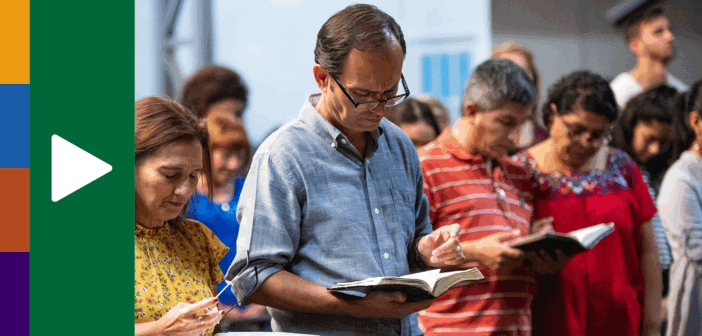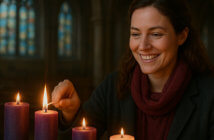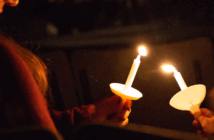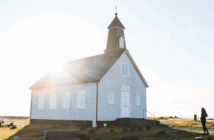
How can a struggling congregation be transformed into a thriving multicultural ministry center? In this episode co-pastors Beth and Nelson Neil share how Culmore Church was transformed through shared space, mutual respect, creative collaboration, and intentional relationships. Their story demonstrates how transparency, flexibility, and mission alignment can revitalize ministry and serve as a model for holistic community engagement.
Listen on Apple Podcasts | YouTube Music | Spotify
Watch on YouTube
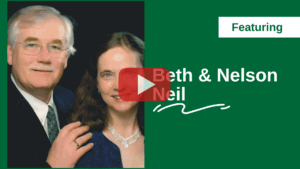
- Transcript — Click or Tap to Read
-
Announcer: Leading Ideas Talks is brought to you by the Lewis Center for Leadership of Wesley Theological Seminary in Washington, DC. Subscribe free to our weekly e-newsletter, Leading Ideas, at churchleadership.com/leadingideas.
Your voice matters! The Lewis Center is conducting a short survey—and your input will shape the future of how we train and support church leaders. Whether you’re clergy, laity, or staff—your opinion matters.The survey only takes 10 minutes to complete. Just click the link in the description or visit churchleadership.com/survey and help us imagine the future of church leadership, together. Again, that’s churchleadership.com/survey.How can a struggling congregation be transformed into a thriving multicultural ministry center? Co-pastors Beth and Nelson Neil share how Culmore Church was transformed through shared space, mutual respect, and creative collaboration, and intentional relationships. Their story demonstrates how transparency, flexibility, and mission alignment can revitalize ministry and serve as a model for holistic community engagement.Jessica Anschutz: Welcome to Leading Ideas Talks, a podcast featuring thought leaders and innovative practitioners. I’m Jessica Anschutz, the interim director of the Lewis Center for Church Leadership, and I am your host for this Leading Ideas talk. Joining me are Beth and Nelson Neil, co-pastors of Culmore Church in Falls Church, Virginia. Thank you, Beth and Nelson, for taking the time to speak with me today about cultivating partnerships among congregations worshiping in Culmore Church and the surrounding community.
Beth & Nelson Neil: It’s great to be here. Thank you.
Jessia Anschutz: Nelson, you have been serving at Culmore Church for 10 years. Where was the congregation when you arrived?
Nelson Neil: When we first arrived, we were really glad to see the diversity of the congregation. We had people from many countries: Central/South America, Africa, Asia; in all there were around seven different languages spoken. But even better, it was a very cohesive group of all of these different cultures. And there was this beautiful legacy from the previous pastors, going all the way back to Pastor Steven Rhodes, who actually wrote a book about it called Where the Nations Meet: The Church in a Multicultural World. He was, in fact, named the distinguished evangelist of the United Methodist Church in 1997.
But that being said, as much as we really loved the congregation, the church itself was in a bit of a shambles. It was struggling financially. The building had fallen into a pretty bad state of disrepair. As a matter of fact, it was assumed by the—by the district that the church would close, and the building would be handed over to another congregation.
So, here we were with a warm and welcoming congregation, but with an infrastructure that was in danger of collapsing. As a matter of fact, by the second year, there was no heat in the building. The antique boiler was actually condemned by the gas company, and guess who didn’t have the $70,000 it was gonna take to replace it? That was the first major hurdle we had to overcome. The walls hadn’t seen a lick of paint in some 30 odd years, and the bathrooms were such a mess that, believe it or not, the people would come to church and the ones that lived close by would go home to go to the bathroom and come back to the church to finish the worship service. So it, it was in pretty bad shape. It wasn’t what I would call a welcoming space.
Jessica Anschutz: It sounds like you had a very welcoming congregation in an inhospitable space. So, Beth, I want to invite you to share with our listeners where is the congregation today?
Beth Neil: Because the people in our congregation didn’t have deep pockets, we had to figure out some way, first, to meet the financial obligations without going into debt. And that’s where Nelson’s business expertise came to the forefront, because he was able to monetize the building in a creative way while growing ecumenical partnership. How did he do it? We were fortunate that there were several independent Spanish-speaking churches that were in search of a place to worship, as well as an Ethiopian Orthodox church that was already established at Culmore. So, we thought, this is an opportunity for us to grow the number of people worshiping in our building, while taking care of the building space, so all worshipers coming in would have a place that they didn’t have to run home to go to the bathroom. What can I say?
So, with the help of our wonderful Peruvian church administrator, we talked with the different pastors about sharing the space. But rather than having this “landlord-rent-[relationship],” we decided to figure a different kind of relationship. One that—yes—they would help us with the rent; yes, they would help us with the administrative care of the building; but they would also be partners in our outreach ministry. So, I think all of the congregations now in the building, I think we’ve got what, six altogether, Nelson?
Nelson Neil: Including ourselves.
Beth Neil: Yes. That all of the congregations take pride in the sharing of the building, and they see it as their church home, not just someplace they land and have to leave. And now, because of the nature of the relationship between us as the anchor church and the other churches, we do have this true sense of partnership and social interaction as well. Because the other congregations also didn’t have deep pockets, but they did have expertise in caring for buildings. They had painters, they had plumbers, they had carpenters. So, many times, Nelson would ask the pastors if they could, instead of paying rent for a month, paint the walls, replace the floors. They even replaced the steeple and the soffits on the building—no mean thing. So, we’ve ended up, without having to go into debt, having a building now that looks really nice and inviting for all of the warm congregations that are worshiping in that building.
Jessica Anschutz: That’s really wonderful. Nelson, I’d love to hear some more about how you work to cultivate those partnerships with the other congregations worshiping in your space.
Nelson Neil: It really all begins with transparency, and mutual respect, and a deep-seated empathy for the needs of the people that are coming into the building. If you treat them as mere renters, then they will be mere renters. But, from the very, very beginning, we treated them as partners. And we were very concerned with what they needed, when they needed it, where they needed to be. And oftentimes that meant actually making physical changes to the building itself. And quite often, it meant doing it with their help, both manually from a labor standpoint, and monetarily. But the look of our building changed as a result of having the people in the building. And we were willing to also move times around and activities around, to accommodate the special needs of some of the worshipers.
For example, the Ethiopian Orthodox Church operates on a different calendar, and so we’ve had to re-engineer during their high holidays when we were going to do certain things. But we did that. The Ethiopian church uses a very different setup than we do. They burn incense. They use iconography. The arc of the covenant is a central part of their worship service. Their setup is very different than ours. The Spanish speaking churches have praise bands with a lot of amplifiers and musical instruments, and so, we had to build space to store all of this stuff in the sanctuary. So, we actually had to build attractive looking storage lockers into the side of our sanctuary for the people there to be able to house all of this stuff so they could put it away and take it out on Sunday mornings. So, the people in our church had to be willing to accept that even the look of their sanctuary would change to accommodate all of this.
Beth Nelson: And if I can add, sometimes when you’ve had a church that’s been established for a long time, people get very protective of the way they want things to look and where people should sit; that idea of you’re sitting in my pew, you’re not supposed to do that. We have to all be a little flexible and be willing to change the way we see things in the church, so that we make space for everybody.
And then one other thing we’ve done to build and cultivate the partnerships is to do joining group activities. For example, we do an annual Thanksgiving dinner for the community and invite all the people in the neighborhood to come. And then the different congregations will have different groups that will provide entertainment. We have the Bolivian dancers. We have the Zumba people (because there’s a Zumba class there too). We have the kids come out and sing, and then the various pastors will greet the people because that annual Thanksgiving dinner is primarily Latino, but everybody comes together. Everybody volunteers to help, so it’s not like one particular group is quote, “the ones doing it.” It’s a joint effort. And we’ve also had—the Ethiopian Orthodox Church—has their kids come in from time to time and sing for us. Who doesn’t like to hear kids sing? So, all of these ways that we get the congregations together socially helps build those connections that make us really cohesive.
Nelson Neil: We’ve stood up a pastor’s council. So, we sit down together as pastors, and we meet to talk about what our churches are doing as outreach in the neighborhood. And we try to do it as one community church. A good example of this is, at one of our food pantries that Culmore sponsors, one of the Latino ministers is always there helping out and members of his church come in and serve as volunteers to hand out the food products to the different families. There’s almost 200 families that show up to receive free produce once a month. And that’s done not only by the Culmore people, but by the people in the other churches.
The other thing is we regularly meet one-on-one with the pastors of the of the different churches to talk about their ministry and to talk about what’s happening with their ministry. How can our churches be closer together? What are their needs, and how can we as a group, better, better help to enable and fulfill those needs.
 Shape the Future of Church Leadership
Shape the Future of Church Leadership
Please take a 10-minute survey to help guide the Lewis Center’s next chapter.
Beth Neil: And a lot of times we tend to think about outreach as a means for community service that I give to you, and you receive and say thank you and go away. But rather than that approach, because again, many people in all of our different congregations are in need themselves. So, by them coming and volunteering, then at the end, they also can receive the food pantry items. We have a Mason and Partners, this free clinic that operates in our building thanks to George Mason University. And this again, is a place that all of the people in our community, many of them need this themselves. So, by [being]willing to assist, they are giving and receiving, so people don’t feel like, “Poor me. You’re up here. I’m down here.” No. Together we are working for the good of our community.
Nelson Neil: One of the things that we really want to be, in spite of our relatively small size as a Methodist congregation, is a relative presence in the community that we serve. And we have stood up three separate food ministries: one in conjunction with the national Capital Area Food Bank, one in conjunction with Grace Ministries, which is a Methodist charity, and one in cooperation with the LDS church. In addition to that, we have as, as Beth mentioned, a free medical clinic and we have an ESL program. Now, these aren’t operated by our church. But they’re hosted in our church and members of our church and other churches go there and serve as volunteers to help enable these programs, which is something that we can do, although we don’t necessarily have the horsepower to lead these particular ministries. We just recently have the “Just Neighbors” have decided to set up a legal counselor to counsel people on immigration rights in the event that they should be challenged. And that person will be sitting there on Thursdays during the MAP clinic. That’s all part of us being identified as a community service hub by Fairfax County.
Jessica Anschutz: I am really impressed with all that you have done, not only to restore the property and the building, but to truly make it a space where all are welcome, and all can use it. And you alluded to the fact of the need to be open to changes; even the look of the sanctuary had to change to accommodate storage for stuff for some of the other congregations. What steps have you taken to help people be more open to the “other,” whoever that other may be?
Beth Neil: Because we are such a diverse congregation, I think people intuitively already know how it feels to be the other, because they are the other in different situations. So, I have seen our congregation reach out, organically, when people come in the door, regardless of how they’re dressed, regardless of the ethnicity, I see them welcoming all. We have people, again, from the neighborhood that come in—we always have a lunch after our service—and everybody comes in and we give them sandwiches. We have the time to talk, and we don’t have to assign greeters, because, again, they do it on their own, from the heart, authentically.
Nelson Neil: One of the things that happened early on in our ministry is two of the churches got together and said, “We like the fellowship hall, but it needs paint. If you supply the paint, we’ll supply the labor.” So, we bought a couple of buckets of paint. They brought a great big cauldron of vegetable soup, stuck it on the stove, and there were about 20 of us that showed up. And in two nights we painted the sanctuary from front end to last. The same church a year later came in and repainted the narthex, and the sanctuary, and fixed the roof. When our people walked in the next day after this work was done, and saw what had happened, and were told who did it, all of a sudden, their minds became much more open to having other people in the space that they had traditionally considered their own.
Jessica Anschutz: You have such a wonderful story to share, but I know that all of this has not been easy. So, I’m curious about what challenges you faced along the way and how they have been addressed.
Nelson Neil: I would have to break that down into couple of different areas. So, the first area would be the interpersonal part of making sure that everybody got along with everybody else. And I can remember one council meeting where somebody said, “Sometimes it just doesn’t feel like my church anymore.” And I tripped up and said, “Well, do you remember being in college? Who here was in college and lived in a dorm?” And a couple of people put their hands up. I said, “So when you had a roommate,” I said, “you know, you couldn’t just throw your stuff around wherever you wanted it.” I said, “you had to take your roommate into consideration.” I said, folks, “We can’t afford a single room. We have to have roommates. We just have to be able to share.” And this message came across and came across and came across. There’s an old saying—I’m French Canadian, and we have this saying that “The more you hammer and nail, the deeper it goes.” You consistently gave this message of, “we need to share our space because if we don’t share our space, we won’t be able to use the space.” And that eventually became part of how we live; to understand that these people aren’t just impinging on our space. They’re enabling us to enjoy the space. So that was the first part.
The second part was financial, and you know, so there had to be a tremendous amount of transparency with our own congregation, showing them how much we had, how much we spent, where our money came from, and how valuable all of this was. But we also had to share that with the people who share the building with us, so that the people who were sharing with us understood how much their contribution was necessary and valued to the ongoing maintenance and success of our cooperative ministry. And those two things were really foundationally important.
And third happened during Covid, when people who stopped using the building stopped paying us any money, but the expenses continued on through. And we actually sat with them and said, “if you want a building here when we get back, we would need you to continue to support us minimally so that we can cover our basic expenses during this time.” And without exception, all of them agreed to contribute.
So, you had this sense of partnership based on authentic communication and transparency and a willingness to understand mutual needs, which empowered us to do that. But there were some character-building conversations.
Beth Neil: Yeah. And I can tell you, because we have several people that have been rescued from being without houses. We had one guy that was working in our church, and he started coming to our service, but he’d sit in the back corner. And then he would come into the narthex where we would have our lunch, and he’d sit by himself. And without us saying a word, people went over and said, “No. Come over and sit with us. Come over and sit with us. Don’t you want some more? Some coffee?” Next thing you know, he became a beloved member of the congregation because people opened their hearts—again, authentically. It wasn’t like, “Oh, it’s my turn to greet. I’ll have to go say hi.” No. They did it from their heart. And because of that, this person now, still, even though they’ve moved down to Tennessee, they come every Sunday. They join us by Zoom, and they join us for Wednesday Bible study. The connections span miles.
Nelson Neil: Yeah. And this is one of more than one example.
Jessica Anschutz: That’s really incredible. As we reflect on Culmore’s story over the last 10 years, from being transformed from a struggling congregation in a building with deferred maintenance to really a thriving community center with multiple congregations worshiping there, what words of advice would you give to church leaders who are seeking to do the same in their context?
Beth Neil: You’ve gotta get outside the doors. You’ve got to talk to people in the neighborhood, and find out what might be the needs, and what are the resources to see: Can we do something joining these two together? Can you make space for people that are different from you? And I think the qualities that come to the forefront are like, having that desire to be cooperative. Being humble. Not saying, “You poor people. We have so much to offer. What can we do for you?” but to say, “We are here, as all of us, as Christ’s disciples. How can we grow the church?” Having that empathy for each other, letting them feel empowered, not disempowered, also can help grow the congregation.
Jessica Anschutz: That’s really wonderful. Beth and Nelson, I have so enjoyed our conversation today, but we need to bring it to a close. So, I want to ask you as we wrap up, “what is your hope for congregations as they seek to engage their communities?”
Neil Nelson: I would hope, first of all, that they seek to find the needs of the community around them, so that, however they choose to partner with others in the community, they can be relevant in the space that they inhabit. That’s the first thing. The second thing that I would do is that I would say, understand what the culture is within your church, and the willingness within your church to be willing to embrace certain changes that might take place. And then partner with people with whom you are aligned.
We were very focused on outreach mission and building disciples of Jesus Christ. We weren’t so concerned that they be United Method Methodist disciples. We just wanted disciples. And for example, when the Boys and Girls Club left us, we had a whole bunch of space, and we made a conscious decision not to ask another preschool or youth enterprise to come into our building to replace that space in revenue. We chose to have churches come in because the churches are aligned with our mission of making disciples of Jesus Christ. And therefore, we ended up with a church full of people who were bringing new people to Christ. And so that sense of alignment is crucially important. So, I would say, people, transparency, authenticity, your own willingness to partner, and then be aligned with the people that you choose to bring in.
Beth Neil: One little point I’d raise too is when you open your space and invite people in that have mission work, that have worship, that feel is part of moving forward building disciples of Christ. You end up with a building full of people morning, noon, and night and the community can look and say, “What’s going on there? I see people going in that building all the time.” One other thing that has been really wonderful and uplifting to see because our church is in the middle of a very difficult area, as I mentioned, a lot of gang activity, drug activity, et cetera. Because we offer services for the community, and because we offer them their de-facto community center where they can do quiñceaneras, they can have celebrations—we have found [very little]graffiti, [and very little]vandalism. They leave the building. They respect the building.
Nelson Neil: Yeah, they do. They do. And they respect the people in it.
Beth Neil: Yes.
Nelson Neil: I’ve never felt unsafe.
Jessica Anschutz: What an incredible story. Thank you, Beth and Nelson, for sharing it with us today.
Beth Neil: It’s been a pleasure to be here. Thank you so much.
Nelson Neil: Thank you for having us.
Announcer: Thank you for joining us for Leading Ideas Talks.
Don’t forget to subscribe to our free weekly e-newsletter, Leading Ideas, to be notified when new episodes are published. Visit churchleadership.com/leadingideas.
Related Resources
- 50 Ways to Take Church to the Community, a free Lewis Center resource
- Community Partnerships: Moving from a Mindset of Scarcity to Abundance featuring Mahogany Thomas — Watch the Leading Ideas Talks podcast video | Listen to the podcast audio version | Read the in-depth interview
- The Multiplying Effect of Community Partnerships by Rosario Picardo
If you would like to share this article in your newsletter or other publication, please review our reprint guidelines.
